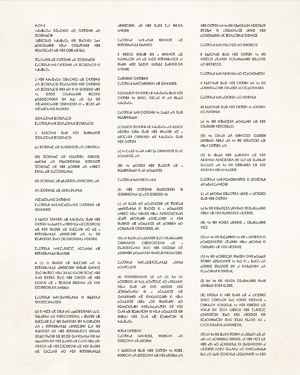National Consensus of Talahara: Difference between revisions
mNo edit summary |
mNo edit summary |
||
| Line 32: | Line 32: | ||
| date_first_court = | | date_first_court = | ||
| date_repealed = | | date_repealed = | ||
| number_amendments = | | number_amendments = 5 | ||
| date_last_amended = February 14, 2008 | | date_last_amended = February 14, 2008 | ||
| location_of_document = | | location_of_document = | ||
| Line 41: | Line 41: | ||
| supersedes = | | supersedes = | ||
}} | }} | ||
The '''Constitution of Talahara''' ({{wp|Central Atlas Tamazight|Takelat}}: ⵇⴰⵏⵓⵏⵀⵍⵓ; ''Qanunhlu'') is the supreme law of the [[Talahara|Communes of Talahara]]. Drafted over a period of three years between 1838 and 1841, the first two parts of the constitution enshrined the rights and freedoms of all persons in Talahara, in addition to democratic and property rights. Part three of the constitution was completed later in 1841 and codified the roles of the three branches of government and divisions of power between national, regional, and communal levels of government. | |||
Both laws created by the [[Supreme Legislative Council (Talahara)|Legislative Councils of Talahara]] and the executive functions of government must abide by the protections and limitations enshrined by the constitution. Constitutional principles are also used alongside Talaharan customary legal principles to interpret laws. | |||
The constitution has been amended a total of five times. These amendments include the addition of the third part, electoral reform, and the addition of new rights and protections. Constitutional amendments require the passage of a provision by a two-thirds supermajority in the Supreme Legislative Council (34 of 50 members) and subsequent ratification by a two-thirds supermajority by the membership of the 1,250 Communal Legislative Councils in Talahara (8,334 of 12,500 members). | |||
==History of the Constitution== | ==History of the Constitution== | ||
Revision as of 15:57, 6 May 2022
This article is incomplete because it is pending further input from participants, or it is a work-in-progress by one author. Please comment on this article's talk page to share your input, comments and questions. Note: To contribute to this article, you may need to seek help from the author(s) of this page. |
| Constitution of Talahara ⵇⴰⵏⵓⵏⵀⵍⵓ Qanunhlu | |
|---|---|
 | |
| Jurisdiction | Talahara |
| Created | May 9, 1841 |
| Date effective | June 20, 1841 |
| System | Directorial council republic |
| Branches | 3 |
| Chambers | |
| Executive | |
| Judiciary | |
| First legislature | June 30, 1841 |
| Amendments | 5 |
| Last amended | February 14, 2008 |
| Commissioned by | Commune Council |
The Constitution of Talahara (Takelat: ⵇⴰⵏⵓⵏⵀⵍⵓ; Qanunhlu) is the supreme law of the Communes of Talahara. Drafted over a period of three years between 1838 and 1841, the first two parts of the constitution enshrined the rights and freedoms of all persons in Talahara, in addition to democratic and property rights. Part three of the constitution was completed later in 1841 and codified the roles of the three branches of government and divisions of power between national, regional, and communal levels of government.
Both laws created by the Legislative Councils of Talahara and the executive functions of government must abide by the protections and limitations enshrined by the constitution. Constitutional principles are also used alongside Talaharan customary legal principles to interpret laws.
The constitution has been amended a total of five times. These amendments include the addition of the third part, electoral reform, and the addition of new rights and protections. Constitutional amendments require the passage of a provision by a two-thirds supermajority in the Supreme Legislative Council (34 of 50 members) and subsequent ratification by a two-thirds supermajority by the membership of the 1,250 Communal Legislative Councils in Talahara (8,334 of 12,500 members).